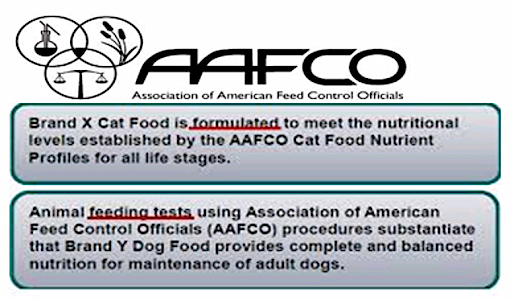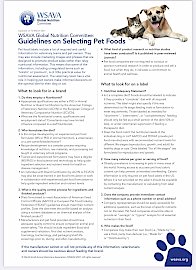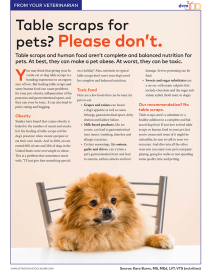Nutrition and Pet Foods
Why is Nutrition Important?
Good nutrition is important for your pet for many reasons. Good nutrition promotes good quality of life and helps your pet stay healthy, happy and active longer. High quality foods help their skin and coat to be healthier, help their immune system to be stronger, and improve their whole body health. High quality also means less waste, so less mess to clean up in the litter box and yard.
A good food provides complete and balanced nutrition for you pet. It provides the proper mixture of minerals and nutrients to support them. Adding other foods, people food, excessive amounts of treats, or vitamins to a high-quality diet is not necessary and may be detrimental. Adding supplements to a poor diet will not make it a good diet – you cannot add supplements to achieve the proper balance of nutrients. Raw/home-cooked diets are often not balanced for your pet. If you are interested in home-cooked diets, we recommend you consult a nutritionist to balance the diet.
Nutritional deficiencies/excesses can lead to severe health problems to include allergies, heart disease, kidney disease, and other organ dysfunction.
How Do I Find the Best Food for my Pet?
We recommend foods that have high quality, consistent ingredients and meet AAFCO (Association of American Feed Control Officials) Standards to include a feeding trial (this must be included on the label). Feeding trials are costly and when done properly, are continued for years to show that the food is appropriate for labeled stages of the pet’s life. Foods labeled as only meeting standards may have the appropriate required ingredients, but these ingredients may not be nutritionally available to the pet, which is why the feeding trials are so critical.
Looking at ingredient lists alone is often not a good judge of a food. A good quality food can have corn and wheat and meat by-products (these include organ meats), which can all be excellent sources of vitamins and minerals. Many newer foods have expensive ingredients but aren’t appropriately tested or balanced. A more expensive food is not necessarily a better food!
Brands of food that we recommend are Science Diet, Royal Canin, Purina ProPlan, and Iams/Eukanuba. Pick a food appropriate to your pet’s life stage (i.e. kitten/puppy, adult, senior). It is also very important that dogs eat dog food and cats eat cat food. Cats require specific ingredients and higher levels of protein than dogs do. We also generally recommend dry foods for dogs, while most cats benefit from at least part of their diet being canned food. There are now many choices of foods which address other issues as well: large breed, sensitive stomach, sensitive skin.
Diets we do not recommend include boutique/exotic/grain free diets, store brands such as Ol’ Roy and Hill Country Fair or raw or home cooked diets that are not properly balanced.
How Do I Feed My Pet?
Puppies / kittens under 3 months of age should be fed four times a day. Between 3 and 5 months of age they should be fed 3 times a day. Adults should be fed twice daily. We recommend controlled feedings for all animals – never just leave food down as this can lead to obesity. Younger animals can usually be switched to an adult food between 6 mos and 1 year of age.
The amount of food you feed your pet depends greatly on their body condition. In general, bag recommendations overestimate the amount of food your pet needs, so it is best to start below the recommendations. If you want a more specific recommendation, we can give you an estimate of your pet’s calorie requirements based on their body condition. Since each pet has a different metabolism, you may still have to adjust the amount based on your pet’s body condition.
Some pets have sensitive stomachs and may become ill or stop eating if their food is changed abruptly. This can happen when a new food alters the intestinal environment, which may lead to diarrhea, vomiting and a refusal to eat—that’s why it’s best to gradually wean your pet off the current food and onto the new one. Try using the “1/4 every 4 days” rule: Add 25% new food every four days until your pet is completely transitioned to the new diet. So feed your pet 75% current food and 25% new food for the first four days, 50% current food and 50% new food for the next four days, 25% “old” food and 75% new for the following four days—and then your pet can be fully transitioned to the new food!
It is not necessary to change your pet’s diet periodically. Pick one that works for them and stay with it. Food changes can upset their gastrointestinal system, causing diarrhea and vomiting.
Your pet may have a specific medical condition which requires a prescription diet or a different regimen than what is mentioned here. If you have any questions about the amount or type of food to give your pet, please ask us – we would be glad to help you in providing your pet with the best nutrition possible for them. Good nutrition is an incredibly important part of preventative medicine.
Grain Free Foods
Grain-free foods are very popular right now, but they are not necessary for most pets and can actually be detrimental in some cases.
Grains are an excellent source of nutrition in pet foods. Pets with food allergies are most commonly allergic to proteins such as chicken and beef. Grains are not a common food allergen. There are rare cases of pets that should be on grain free diets for specific health reasons, but this is very uncommon.
Recently, grain-free, boutique and exotic diets have been implicated in cases of dilated cardiomyopathy (DCM) in dogs not normally prone to this type of heart disease. It seems to be associated with diets where legumes (beans, peas, chickpeas) and/or potatoes are one of the top ingredients. The specific factor which triggers the DCM has not been identified. This is only a problem with dogs; no heart disease has been identified in cats on a grain free diet.
As a precaution, we recommend our clients with dogs on grain-free diet consider changing to a normal diet.
- FDA INVESTIGATION INTO POTENTIAL LINK BETWEEN CERTAIN DIETS AND CANINE DILATED CARDIOMYOPATHY
- A BROKEN HEART: RISK OF HEART DISEASE IN BOUTIQUE OR GRAIN-FREE DIETS AND EXOTIC INGREDIENTS
- CVCA Guidance for Pet Owners on Grain-Free Foods
Raw Foods
Raw diets are another type of feeding that has grown in popularity. We have a number of concerns with raw diets to include appropriate nutrient balance and risk of exposure to pathogens to include parasites and bacteria.
A raw food diet (RFD) usually includes raw muscle meat, organ meat and ground bones. Although a raw food diet may seem to resemble the diet of a wild dog or cat, it may not be appropriate for domestic pets. The FDA, CDC, and AVMA do not recommend raw food diets for pets due to the risks of nutrient deficiencies and illnesses.
If you choose a commercially prepared RFD, experts recommend finding one formulated by a veterinary nutritionist. Also look for RFDs that have undergone feeding trials and meets to ensure your pet gets all the nutrients needed.
In addition to the risk of nutrient deficiencies, raw diets pose other risks. Any bones not completely ground up could cause intestinal blockages or even lacerations. Raw foods are more likely to be contaminated with harmful bacteria like Salmonella, E. coli and Listeria. These foodborne pathogens could cause a variety of problems for pets and family members, including diarrhea and vomiting. In severe cases, the results can be fatal.To reduce the spread of bacteria, use gloves when handling the raw food and thoroughly clean your prep surfaces. There is still a risk of transmission to people from the pet licking the owner or from a cat grooming and then being petted.
- Myth: Raw Food Diets have better digestibility and more protein and higher nutrient content and that the cooking process reduces those nutrients.
- Fact: Some cooking processes may even make certain foods more digestible and nutrients more available than they were raw. Cooking food at the proper temperature and pressure can actually make the proteins and starches more easily digestible.
Feline Specific Considerations
Our feline companion have some unique requirements when it comes to foods and feeding.
- They are obligate carnivores, which means their bodies require nutrients only available in meat. Cats cannot be fed a vegetarian diet. Their nutrient profile must contain a meat-sourced protein. Unlike dogs, who need 23 essential vitamins and minerals, cats need 25.
- Cats cannot accept responsibility for feeding themselves without overeating. Free fed cats are at high risk for becoming overweight. Food should be carefully chose and measured to meet your cat’s calorie needs without risking weight gain.
- Cat foods are very tasty and very calorie-dense, which means a little goes a long way.
- Cats are neophiliacs, meaning they appreciate trying new things. They may get bored eating the same food the same way day in and day out. Mixing wet and dry cat food for a meal or feeding them at separate meals is a good way to give your cat the variety they not only want, but also need. It’s also a good idea to try a few different serving methods. Some cats prefer their wet food “fluffed” and served on a flat plate or wide, low-edged bowl. Others will eat straight out of the can. Once you find a food and serving method your cat loves, they’ll enjoy eating a mix of wet and dry cat food on a regular basis.
Which is better: Wet or Dry cat food?
If you’ve wondered which is better when it comes to wet vs. dry cat food, they’re both excellent choices. Just make sure the food you select is 100 percent complete and balanced for your cat’s age and life stage. While some cats (and cat owners) prefer one over the other, the best option may be to feed your cat both.
Should I be giving my cat milk?
Kittens drink their mother’s milk until the mother gradually weans them as early as 4 weeks old. Kittens are typically eating solid foods by 8-10 weeks old. Although kittens can drink their mother’s milk, many cats lose the ability to process sugar found in milk after weaning. Because of this loss of the ability to process the sugar found in milk, it can cause gastrointestinal problems, therefore milk isn’t healthy for most cats, especially if it’s taking the place of a balanced meal.
Key Points
| Wet food benefits | Dry food benefits |
| Should not be left out for more than 30 to 60 minutes at a time to prevent bacterial growth. | There’s less risk of bacterial growth so you can leave it out all day. |
| Easier for cats to chew. | Dry cat food may be more difficult for older cats to chew. |
| Helps increase total water intake. | May help reduce plaque and tartar buildup on cats’ teeth. |
| More variety in diet with flavors and textures. | More cost effective/convenient. |
- Good nutrition is key to your pet’s overall health.
- More expensive does not necessarily equal better for your pet!
- Grain Free diets are rarely necessary and can cause fatal heart disease in dogs.
- AAFCO Standards and Feeding Trials are critical to a good quality food.
Diet History Forms
Resources
- Pet Nutrition Alliance
- Petfoodology
- Weethnutrition
- The Savvy Cat Owner's Guide to Nutrition on the Internet
- How to Switch Foods [PDF]
- Raw Diets Pamphlet [PDF]
Click the below Images to view our Handouts
- Academy of Veterinary Nutrition Technicians
- American Society of Clinical Nutrition
- American Society for Parenteral & Enteral Nutrition
- Association of American Feed Control Officials
- Consumerlab.com (tests dietary supplements for purity, potency, bioavailability, etc)
- FDA Center for Veterinary Medicine
- FDA Recall List
- NIH National Center for Complementary and Alternative Medicine
- Nutrition Advisory Group to the American Zoo and Aquarium Association
- Pet Food Institute
- Pet Food Institute Consumer Information
- USDA Food and Nutrition Information Center (general supplement and nutrition information, links to a variety of dietary supplement websites)
- United State Pharmacopeia Dietary Supplement Verification Program
- Raw Meat Diets Information
Cookies on this website are used to both support the function and performance of the site, and also for marketing purposes, including personalizing content and tailoring advertising to your interests. To manage marketing cookies on this website, please select the button that indicates your preferences. More information can be found in our privacy policy here.






